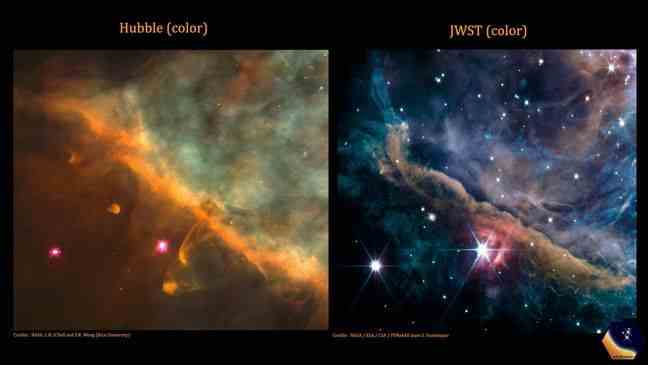In one of the offices of the Institute for Research in Astrophysics and Planetology in Toulouse, since last weekend, we have been running on coffee. Since the arrival of observational data from the James Webb Telescope (JWST) on Sunday, and the publication of the first images of the Orion Nebula on Monday evening, a small team has been working hard to reveal to the great public a new “view” of the richest and closest stellar nursery in the solar system. A much cleaner version than the one previously provided by Hubble.
And that was no small feat, because when the first data arrived, it looked more like a white dot on a blurry black background than a painting board. But 24 hours of treatment – and months of preparation – have made it possible to achieve this ever more stunning result. “We started with the raw data from the telescope, which we pre-processed to have black and white images of the different filters which we then assembled, then a graphic designer made a colored composition”, explains Olivier BernéCNRS researcher at the Institute for Research in Astrophysics and Planetology of Toulouse (IRAP).

This gives a more detailed and clearer vision of what is happening 1,350 light years from Earth, in an environment similar to that where our system was born more than 4.5 billion years ago.
The role of the “breath” of the stars
“When we receive these images, we immediately look at the details and we see the differences with the images of the past, in particular those of Hubble. We see that there are more contrasts and depth. We can see the three dimensions of the nebula. We observe these stars which light up, these young stars which are tens, hundreds of thousands of years old and which we did not see with Hubble”, continues the astrophysicist.
Thus appear to the eyes of the general public, structures in filaments, like sponges, which are certainly linked to the interaction of the wind of the stars with the cloud. “We have stars that illuminate the nebula but also cause winds, a breath on their entire environment. And the interaction of this breath with the cloud creates these types of structures. A bit like when the wind blows on the surface of the water, it creates wrinkles. And that certainly has an impact on the way a star forms, or does not form, “says the man responsible for one of the 14 priority scientific projects on the JWST telescope.
A question at the heart of many works by astrophysicists around the world. Why in a galaxy, where there is a lot of matter and interstellar clouds, only two or three stars are formed per year. What prevents the stars from seeing the light of day?
Water molecules and carbon monoxide detected
There are several avenues under study, which these new images could enrich. Either they are mechanical reasons, like the breath of the stars which disturb the clouds. Either by heating effects. Much closer than the Carene or Tarantula nebulae, also in the viewfinder of James Webb, that of Orion will make it possible to see more clearly the small stars in formation. Or what looks like a globule on the image captured by the telescope, where in the middle is a star, and this disc which surrounds it, which is none other than a planetary system in formation where the details appear.

“With James Webb, we can see the spectra of these forming planetary systems, and their composition. Thanks to a spectrometer, which breaks down the light emitted by the objects of the nebula, we can see which molecules are present, and, later, we will see where they can come from”, reveals Olivier Berné. He can already tell that they have definitely detected water molecules, carbon monoxide and what could be carbon oxysulphide.
And it’s far from over, because of the 40 hours of observation enjoyed by the Toulouse team for its research project, only three for the images and nine for the spectrometer were devoted to these images. There is still plenty of data to exploit and new things to learn about this fabulous nebula of Orion.

